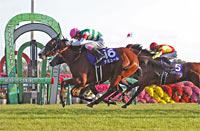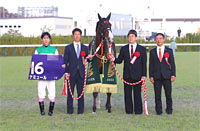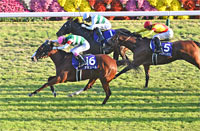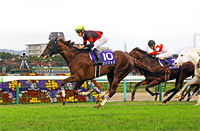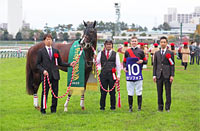Mile Championship (G1) - Data Analysis
Look out for dark horses in the autumn mile champion decider
Although the top five favorites occupied the first five places in last year's Mile Championship, horses backed as 8th favorite or lower occasionally made their way into the runner-up spot in previous years. And while the 1st favorite enjoyed Top 2 finishes on 11 consecutive occasions from the first race in 1984 to the 11th in 1994, the favorite has not won in the last six years. So how will things pan out this year? With that question firmly in mind, let's look at some trends in this race based on results over the last 10 years.
Check trends in favoritism
Viewing aggregate performances in terms of favoritism over the last 10 years, the 1st favorite has chalked up some highly impressive figures including a Top 3 ratio of 80.0%. However, the favorite has not only failed to win in the last six years, as stated above, but has not even managed a Top 2 finish in the last three. Given that the 1st favorites were reliable finishers with three wins and one 2nd place finish over the four years between 2006 and 2009, the fact that they have been less successful in recent years should be borne in mind. [Table 1]
[Table 1] Performance by favoritism (last 10 years)
| Favoritism |
Performance
1st-2nd-3rd-4th or lower |
Win ratio |
Top 2 ratio |
Top 3 ratio |
| 1st favorite |
3-3-2-2 |
30.0% |
60.0% |
80.0% |
| 2nd favorite |
1-1-1-7 |
10.0% |
20.0% |
30.0% |
| 3rd favorite |
0-3-0-7 |
0% |
30.0% |
30.0% |
| 4th favorite |
3-1-1-5 |
30.0% |
40.0% |
50.0% |
| 5th favorite |
1-0-2-7 |
10.0% |
10.0% |
30.0% |
| 6th-10th favorite |
1-0-4-45 |
2.0% |
2.0% |
10.0% |
| 11th favorite or lower |
1-2-0-76 |
1.3% |
3.8% |
3.8% |
If we look next at aggregate performances by win odds, we find that runners with odds of “2.9 or less” have an unblemished Top 2 ratio of 100%. Those backed by odds of “3.0-3.9 or less” have also achieved a Top 3 ratio of 100%, indicating a constant presence among the top finishes. When weighing up the merits of the 1st favorite, it would seem wise to focus on the odds offered. [Table 2]
[Table 2] Performance by win odds (last 10 years)
| Win odds |
Performance
1st-2nd-3rd-4th or lower |
Win ratio |
Top 2 ratio |
Top 3 ratio |
| 2.9 or less |
2-1-0-0 |
66.7% |
100% |
100% |
| 3.0-3.9 |
1-1-2-0 |
25.0% |
50.0% |
100% |
| 4.0-6.9 |
2-4-0-14 |
10.0% |
30.0% |
30.0% |
| 7.0-9.9 |
1-2-3-4 |
10.0% |
30.0% |
60.0% |
| 10.0-19.9 |
3-0-3-36 |
7.1% |
7.1% |
14.3% |
| 20.0-49.9 |
0-2-2-48 |
0% |
3.8% |
7.7% |
| 50 or more |
1-0-0-47 |
2.1% |
2.1% |
2.1% |
Also check the previous race
Turning next to performances in terms of the runners' previous race over the last 10 years, those coming straight from a G1 race have enjoyed success here when the race in question was the Tenno Sho (Autumn). However, the only Top 2 finishers coming from other G1 races were last year's winner Maurice (previous race: Yasuda Kinen) and the 2011 runner-up Fifth Petal (Sprinters Stakes). Meanwhile, runners most recently seen in graded races other than G1 seem to have more affinity with this race if the venue was Kyoto Racecourse, rather than Tokyo Racecourse. [Table 3]
[Table 3] Performance by previous race (last 10 years)
| Previous race |
Performance
1st-2nd-3rd-4th or lower |
Win ratio |
Top 2 ratio |
Top 3 ratio |
| Tenno Sho (Autumn) |
4-1-1-14 |
20.0% |
25.0% |
30.0% |
| 1,600m G1 |
1-0-2-9 |
8.3% |
8.3% |
25.0% |
| Other G1 |
0-1-1-16 |
0% |
5.6% |
11.1% |
| Swan Stakes |
1-5-2-33 |
2.4% |
14.6% |
19.5% |
| Kyoto Daishoten |
1-0-0-1 |
50.0% |
50.0% |
50.0% |
| Fuji Stakes |
2-2-1-45 |
4.0% |
8.0% |
10.0% |
| Other G2, G3 at Tokyo |
1-1-2-19 |
4.3% |
8.7% |
17.4% |
| Other races |
0-0-1-12 |
0% |
0% |
7.7% |
Look at the performance by finish in the previous race
If we analyze performances over the last 10 years in terms of the runners' finish in their previous race, we find that winners last time out have the best success ratios, including five victories. By contrast, those finishing 2nd to 5th in their previous outing have only produced one winner here, and their success ratios are poor. In fact, runners with a finish between 6th and 9th last time out have recorded better performances. [Table 4]
[Table 4] Performance by finish in the previous race (last 10 years)
| Finish in previous race |
Performance
1st-2nd-3rd-4th or lower |
Win ratio |
Top 2 ratio |
Top 3 ratio |
| 1st |
5-4-4-19 |
15.6% |
28.1% |
40.6% |
| 2nd |
0-2-1-14 |
0% |
11.8% |
17.6% |
| 3rd |
1-1-2-15 |
5.3% |
10.5% |
21.1% |
| 4th, 5th |
0-0-2-25 |
0% |
0% |
7.4% |
| 6th-9th |
4-3-1-37 |
8.9% |
15.6% |
17.8% |
| 10th or lower |
0-0-0-39 |
0% |
0% |
0% |
If we narrow this down to those finishing 6th to 9th in their previous outing, focusing this time on the actual race contested, we find that horses beaten to 6th-9th in the Tenno Sho (Autumn) or Sprinters Stakes have a higher probability of achieving a rebound in this race. The only horse to rebound from 6th to 9th in the Swan Stakes (the main trial for the Mile Championship) to win this race was the 2010 winner A Shin Forward (8th in the Swan Stakes). Incidentally, this horse had entered the Swan Stakes as the 1st favorite. [Table 5]
[Table 5] Performance of horses finishing 6th to 9th last time out, by race (last 10 years)
| Previous race |
Performance
1st-2nd-3rd-4th or lower |
Win ratio |
Top 2 ratio |
Top 3 ratio |
| Tenno Sho (Autumn) |
2-1-0-3 |
33.3% |
50.0% |
50.0% |
| Fuji Stakes |
1-1-0-13 |
6.7% |
13.3% |
13.3% |
| Swan Stakes |
1-0-0-9 |
10.0% |
10.0% |
10.0% |
| Sprinters Stakes |
0-1-1-1 |
0% |
33.3% |
66.7% |
| Other races |
0-0-0-11 |
0% |
0% |
0% |
Check the record of contesting G2 races before and after the Mile Championship
In the Mile Championship over the last 10 years, horses that “contested 1,400-1,800m G2 turf races in spring and autumn that year” have finished in the Top 2 every year except 2011. If any of this year’s runners comes with such a record, it would be a good idea to check it out. [Table 6]
[Table 6] Top 2 finishers in the Mile Championship with records of contesting 1,400-1,800m G2 turf races in spring and autumn that year (last 10 years)
| Year |
Finish |
Horse |
Spring G2 race contested |
Autumn G2 race contested |
| 2006 |
1st |
Daiwa Major |
Yomiuri Milers Cup |
1st favorite |
1st |
Mainichi Okan |
3rd favorite |
1st |
| 2nd |
Dance in the Mood |
Yomiuri Milers Cup |
2nd favorite |
2nd |
Mainichi Okan |
2nd favorite |
2nd |
| 2007 |
2nd |
Super Hornet |
Yomiuri Milers Cup |
10th favorite |
15th |
Swan Stakes |
3rd favorite |
1st |
| 2008 |
2nd |
Super Hornet |
Keio Hai Spring Cup |
2nd favorite |
1st |
Mainichi Okan |
2nd favorite |
1st |
| 2009 |
1st |
Company |
Yomiuri Milers Cup |
3rd favorite |
2nd |
Mainichi Okan |
4th favorite |
1st |
| 2010 |
1st |
A Shin Forward |
Keio Hai Spring Cup |
1st favorite |
4th |
Swan Stakes |
1st favorite |
8th |
| 2012 |
2nd |
Grand Prix Boss |
Keio Hai Spring Cup |
5th favorite |
7th |
Swan Stakes |
3rd favorite |
1st |
| 2013 |
2nd |
Daiwa Maggiore |
Keio Hai Spring Cup |
1st favorite |
1st |
Swan Stakes |
4th favorite |
2nd |
| 2014 |
2nd |
Fiero |
Yomiuri Milers Cup |
1st favorite |
2nd |
Swan Stakes |
2nd favorite |
3rd |
| 2015 |
2nd |
Fiero |
Yomiuri Milers Cup |
1st favorite |
3rd |
Swan Stakes |
1st favorite |
2nd |
* When there is more than one race in question, the most recent one is shown.
Seek out the winner!
Focus on G3 favoritism within the last five outings
Each of the last five winners of the Mile Championship had previous experience of “contesting G3 races as the 1st favorite within their last five outings.” Although horses coming via G1 or G2 routes generally command attention, the level of favoritism when competing in G3 races is also worth a look. [Table 7]
[Table 7] Winners' experience of backing as 1st favorite in G3 races within their last five outings (last 5 years)
| Year |
Winning horse |
Race in question |
| 2011 |
Eishin Apollon |
Last race |
Fuji Stakes |
1st favorite |
1st |
| 2012 |
Sadamu Patek |
5 races back |
Sports Nippon Sho Kyoto Kimpai |
1st favorite |
5th |
| 2013 |
Tosen Ra |
5 races back |
Niigata Kinen |
1st favorite |
7th |
| 2014 |
Danon Shark |
Last race |
Fuji Stakes |
1st favorite |
7th |
| 2015 |
Maurice |
2 races back |
Lord Derby Challenge Trophy |
1st favorite |
1st |
* When there is more than one race in question, the most recent one is shown.
(Yasunori Asano)
|














